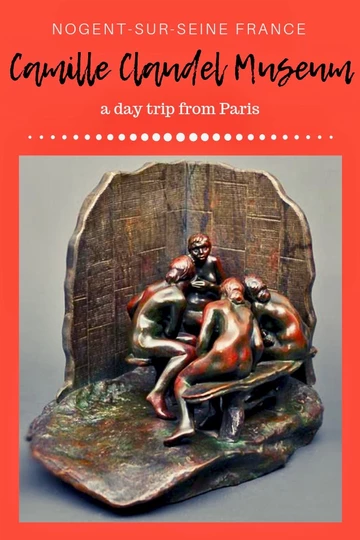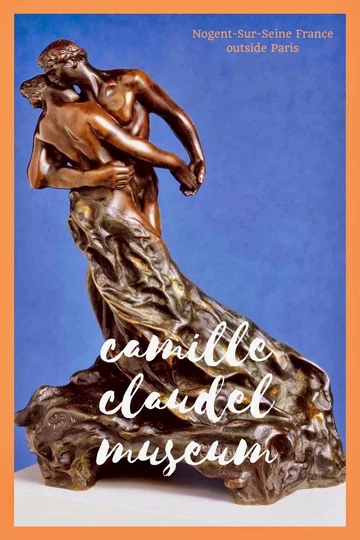“Your favorite virtue? “I don’t have any: they are all boring.” — Camille Claudel
Here’s my guide to visiting the Camille Claudel Museum in Nogent-sur-Seine France. I adore Camille Claudel and her sculpture. I’ve written about her at great length before. She was an undisputed genius, one of the greatest sculptors of her time, male or female.
A museum dedicated to her, the Camille Claudel Museum, finally opened in May 2017. It was the first museum in France dedicated to a female artist.
The museum’s located 60 miles southeast of Paris in the quaint town of Nogent-sur-Seine, an easy day trip form Paris. Claudel lived there for three years as a teen. It’s where she made her first clay sculptures. The museum boasts the largest public collection of Claudel’s works in the world.
Claudel’s great niece Paris says the museum is official recognition of “her art and her genius.” It’s also “a way to separate her from Rodin,” her mentor and lover. The bulk of the museum’s collection is 43 works that Paris sold to the museum for $13.5 million.
Camille Claudel, the Woman and Artist
Camille Claudel moved to Paris at 17 and began studying at the progressive Academic Colarassi. At 19, she was apprenticed to Auguste Rodin. In 1886, Claudel and Rodin began a torrid affair. Their romantic and collaborative relationship would last, on and off, until 1898.
For Rodin, this marked an incredibly prolific period in his oeuvre, with Claudel as his inspiration and muse. For Claudel, the relationship was both a blessing and a curse. Her art received early exposure and acclaim, but she was repeatedly dismissed as a mere protege and her sculpture was deemed derivative.
In 1893, when Rodin lacked the will to leave his lifelong companion, Claudel broke off the affair, walked out of his life, and opened her own studio.
She did some of her best work — The Waltz, The Age of Maturity, Clotho, and The Gossips. But no one bought her work.
Resentful of Rodin, and living in dire poverty, she eventually devolved into an acutely paranoid form of madness, fueled by alcohol and isolation. She destroyed most of her work or tossed it into the Seine.
In 1913, her fervently religious brother Paul Claudel committed her to an asylum. Despite regaining her sanity and begging for her release, Claudel’s family ignored her wishes. She remained there for 30 years, basically imprisoned for being unconventional. She died alone and was buried in a common grave.
Her work was consigned to the dust bin of history for decades.
Then, in 1984, her great niece Reine-Marie Paris wrote a biography of Claudel, denouncing her family’s treatment of the sculptor. Two star studded biopics followed. The Rodin Museum renovated its Camille Claudel Room and launched at exhibition of her work.
Then, in May 2017, the Camille Claudel Museum opened in Nogent-sur-Seine, her family’s previous home, to great fanfare.
During an auction in November 2017, 20 extremely rare works by Claudel owned by her sister Louise Claudel sold for a record-shattering $4.1 million, more than three times the high estimate. They were the last works in private hands and showed that the market finally recognizes the quality of her works.
Highlights of the Camille Claudel Museum
The town transformed and extended the former Claudel family home to create a three story exhibition space.
Designed by the architect Adelfo Scaranello, the museum blends a modern facade with the clay bricks that inspired Claudel. The interior is fairly austere, but that keeps the focus on the art. There are numerous short films on Claudel.
Golden Age Of French Sculpture
The museum starts with a room dedicated to the “Golden Age” of French sculpture showcasing artists who influenced Claudel as a young girl: Paul Dubois, Alfred Boucher, and Marius-Joseph Ramus.
Boucher first recognized Claudel’s talent when she was a teen in Nogent. He provided feedback on her sculptures and urged the Claudel family to move to Paris. When Boucher left for Italy, he asked Rodin to become her teacher.
The next room focuses on various sculptural materials and techniques used in the 19th century, especially clay, plaster, or wax that were then transformed into more durable bronzes and marbles.
Room 3 centers on public commissions.
There is a large collection of plaster sculptures, works that might have been consigned to storage in a major metropolitan museum. Boucher’s Monument to the Doctor Louis Léopold Ollier is almost 12 feet tall. Unfortunately, Claudel herself did not benefit from public commissions.
.There are other thematic rooms that feature mythological and historical topics and explore movement in sculpture.
You then arrive at “Rodin’s Studio.” I’m personally not sure any Rodin works really needed to be in this museum.
But the room has some interesting comparisons of the work of Claudel and Rodin. You see both of their Crouching Women. You see a version of Claudel’s Abandon between versions of Rodin’s Eternal Idol and Eternal Springtime — all depict amorously interlaced couples.
Claudel’s Work
On the second floor lies the work of Camille Claudel in five galleries. Here, the real art begins, loosened from lifeless 19th century constraints. Her sculptures are rougher. They show more movement and emotion.
The first room focuses on Claudel as a portraitist and you’ll find several busts of Paul and one of Rodin. There’s also a lovely version of La Petit Chatelaine, a work of quiet vulnerability, currently on loan.
The museum has four small versions of The Waltz, two versions of The Gossips, and two versions of Deep Thought.
The sublime Waltz essentially has its own room, in Room 13. The only other sculpture is Fortune, 1902–04. It’s based on The Waltz and was cast in bronze by Claudel’s dealer, Eugene Blot in 1905.
Claudel attempted to gain a large marble commission for The Waltz. But the art inspector who visited her studio in 1892 was offended by “the closeness of the sexual organs… rendered with a surprising sensuality.” Only men were allowed in this domain.
The museum also recently acquired Claudel’s Young Girl with a Sheaf. This work preceded Rodin’s Galatea by three years. It confirms that Rodin was also influenced by Claudel, not just the other way around. It makes one wonder how much of the Gates of Hell was Rodin and how much was Claudel …
Claudel’s Masterpiece: The Age of Maturity
In Room 14, you’ll find Claudel’s masterpiece, L’Age mûr, or The Age of Maturity — my very favorite work of hers. It can be interpreted as an allegory on aging or as a wrenching depiction of events in her life. There is a large scale version of this piece in Paris’ Musee D’Orsay.
The Age of Maturity was exhibited in plaster in 1899, before being cast in bronze in 1902. The original work, commissioned by the French state in 1895, was likely destroyed by Claudel after its second casting in 1913.
The sculpture depicts three naked figures. A young woman on her knees implores an older man not to be led away by an older woman. In this version, her outstretched hands have just been released from the man’s grip.
The sculpture is usually interpreted as an autobiographical love triangle between Rodin, his aging and jealous companion Rose Beuret, and his young lover Claudel.
Beuret captures the prize and leads a reluctant Rodin away from a devastated Claudel. The sculpture’s drapery around the male figure may suggest that by rejecting passionate love in favor of domestic equilibrium, Rodin has emasculated himself.
The autobiographical derivation of Age of Maturity is reinforced by some nearby Rodin sculptures of Claudel, on long term loan from the Musee Rodin in Paris, which emphasize their relationship.
Claudel also produced a group of angry drawings caricaturizing Beuret. She depicted Beuret both as a witch with a broom and with her back glued to Rodin.
Paul Claudel hated The Age of Maturity. He said of it: “My sister Camille, imploring, humiliated, on her knees, that superb, proud creature, and what is being wrenched from her, right there before your very eyes, is her soul.”
The sculpture doubles as an allegory on aging. The man is leaving his youth and moving towards the inescapable forces of old age and death.
Either way, it’s a thought-provoking symbolic work about human relationships.
In Room 15, you’ll find Claudel’s intimate pieces from everyday life.
There are two versions of The Gossips and of Deep Thought. The Gossips depicts four perfectly coiffed females gossiping in hushed tones. Deep Thought shows a woman ruminating over the ashes of her life. In both, Claudel addresses mental frailty from a female perspective, much like Frida Kahlo would later do.
The museum also has Claudel’s only monumental marble sculpture and the product of a private commission, Perseus and the Gorgon.
It’s a theme from mythology — the Greek hero Perseus clutching the severed head of the Gorgon. But in Claudel’s sculpture, the face of the Gorgon is a self portrait. It’s a deeply personal piece, reflecting her fraught psyche at the time.
The marble sculpture was a private commission. It was displayed outside rather than inside at the Salon of 1902, prompting Claudel to complain about its lack of visibility and exposure to the elements.
In the male-dominated milieu of her day, Claudel was an unconventional freak. Even to an admirer like art critic Octave Mirbeau, she was “something unique, a revolt of nature: a woman of genius.” Don’t miss her museum.
Practical Information and Tips for Visiting the Camille Claudel Museum:
Address: 10 rue de Gustave Flaubert, 10400 Noget-sur-Seine, 1 hour from the Gare de l’Est station in Paris. The museum is a 10 minute walk from the train station.
Hours: Open Wed-Sat 11:00 am to 6:00 pm & Sunday 1:00 am to 6:00 pm
Entry fee: € 7, under 26 free, audio guide included in entry fee
Tel: +33(0) 3 25 24 76 34
Website
If you liked it, pin it!



Surely the Musée-atelier Yvonne Guégan in Caen was the first museum dedicated to a female artist?
Haven’t been to that particular museum. But I will look it up. Thanks!